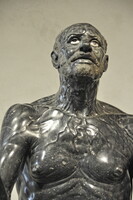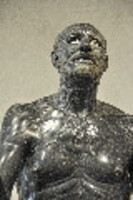| dc.coverage.spatial | Site: Musée du Louvre (Paris, Île-de-France, France) MR 314 (Ma 1354) | en_US |
| dc.coverage.temporal | copy ca. 2nd century (creation) | en_US |
| dc.creator | unknown (Ancient Roman) | en_US |
| dc.date | 100-199 | en_US |
| dc.date.accessioned | 2013-12-31T16:15:40Z | |
| dc.date.available | 2013-12-31T16:15:40Z | |
| dc.date.issued | 100-199 | en_US |
| dc.identifier | 245346 | en_US |
| dc.identifier.other | archrefid: 2841 | en_US |
| dc.identifier.uri | http://hdl.handle.net/1721.3/153784 | |
| dc.description | Detail, head with inlaid eyes and upper torso; Roman copy of the 2nd century after a Hellenistic original. Found in Rome. The statue is mentioned in the collection of Cardinal Altemps in 1599 and was subsequently acquired by Cardinal Scipione Borghese (1587-1623). The figure probably represents an angler, a statue type first created in the Hellenistic period. Heavily restored and placed in a blood-red basin, it was identified with Nero’s tutor, Seneca, who was later ordered to kill himself. The statue was very famous and is the subject of Rubens’ painting “The Death of Seneca" (Alte Pinakoteck, Munich). Source: Louvre Museum [website]; http://www.louvre.fr/ (accessed 4/29/2013) | en_US |
| dc.format.medium | Black marble and alabaster, basin in violette breccia marble | en_US |
| dc.rights | © Scott Gilchrist, Archivision, Inc. | en_US |
| dc.subject | human figure | en_US |
| dc.subject | literary or legendary | en_US |
| dc.subject | Imperial (Roman) | en_US |
| dc.subject | Hellenistic | en_US |
| dc.title | Old fisherman, called the “Dying Seneca” | en_US |
| dc.type | image | en_US |
| dc.rights.access | Licensed for educational and research use by the MIT community only | en_US |
| dc.identifier.vendorcode | 7A3-R-L-OF-A03 | en_US |
| vra.culturalContext | Ancient Roman | en_US |
| vra.technique | carving (processes) | en_US |
| vra.worktype | sculpture (visual work) | en_US |
| dc.contributor.display | unknown (Ancient Roman) | en_US |



